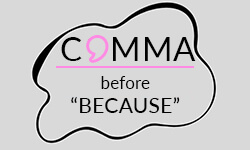
Many students struggle with using commas correctly in academic writing, which can lead to mistakes and confusion. This is usually because they don’t fully understand the rules and exceptions that apply. This article aims to clarify when to use commas before the conjunction “because” by providing examples and explaining any exceptions to the rule.
When to place a comma before “because”
Most of the time, a comma before “because” should not be placed when it connects two clauses in a sentence. “Because” is a subordinating conjunction. This means that the word connects a subordinate clause to an independent clause. A good style dictates that there should be no comma between two clauses except if the lack of a comma causes ambiguity. However, if “because” introduces an independent clause or complete sentence, a comma is not necessary. The same rule applies when “because” is used to introduce a restrictive clause that is integral to the sentence’s meaning.
Comma
More clarity
No comma
Restrictive clauses
Complete sentence
The rules for using commas may differ depending on the Style Guide you follow. Additionally, some complex sentences may have exceptions to the standard comma placement rules. Remember to consider the necessity of a comma to ensure the clarity and readability of your sentence.
Comma before “because”
When using “because” to connect two clauses, no comma should be placed between those. However, there are exceptions. One is that the lack of a comma causes ambiguity.
More clarity
Using a comma before “because” leads to more clarity and avoids confusing the reader. Sentences that start with a negative statement are often confusing. The following examples will illustrate these.
You would not need a comma necessarily in all these sentences. However, placing a comma before “because” connects the two clauses. Without one, it can be implied that, for instance, there was no relationship between her not going out in the rain and having forgotten her umbrella.
No comma before “because”
Generally, no comma is placed before “because” if the word introduces a restrictive clause or if it is written after a preposition.
Restrictive clause
When “because” is used to introduce a restrictive clause, a comma is not placed. This clause is essential to the meaning of the sentence and defines what you are referring to. Removing it would make the meaning ambiguous and less precise. It’s important to note that restrictive clauses should never be separated by a comma.
Complete sentence
When “because” introduces a complete sentence or an independent clause, it does not require a comma.
Special case: Comma after “because”
In most cases, it is not necessary to use a comma after “because.” However, it is appropriate to include a comma when using an introductory dependent clause. It’s important to note that starting a sentence with “because” is grammatically incorrect. It is commonly used, however, in everyday speech but should be avoided in academic writing since it is colloquial.
Test yourself!
Practice sheet
To test your comprehension of using commas before and after “because”, try placing them in the correct positions in the 10 sentences. Afterward, check the answer tab to verify if you have understood the comma usage of the conjunction “because”.
- She couldn’t come to the party because she had to work late.
- We decided to stay indoors because it was raining heavily.
- They decided to cancel the event because the weather forecast predicted heavy rain.
- They cancelled the game because of the thunderstorm.
- I couldn’t finish the project because I lacked the necessary resources.
- I didn’t want to eat the cake because I was on a diet.
- The event was postponed because unfortunately the guest speaker fell ill.
- The class was cancelled because the teacher was sick.
- He didn’t see the sign because it was obscured by the trees.
- Because of the traffic jam they arrived late for the meeting
- She couldn’t come to the party because she had to work late. (No comma)
- We decided to stay indoors because it was raining heavily. (No comma)
- They decided to cancel the event, because the weather forecast predicted heavy rain. (Comma)
- They cancelled the game because of the thunderstorm. (No comma)
- I couldn’t finish the project because I lacked the necessary resources. (No comma)
- I didn’t want to eat the cake because I was on a diet. (No comma)
- The event was postponed because, unfortunately, the guest speaker fell ill. (Comma)
- The class was cancelled because the teacher was sick. (No comma)
- He didn’t see the sign because it was obscured by the trees. (No comma)
- Because of the traffic jam, they arrived late for the meeting. (Comma)
numerous advantages for Canadian students:
- ✓ 3D live preview of your configuration
- ✓ Free express delivery for every order
- ✓ High-quality bindings with individual embossing

FAQs
The use of a comma before “because” helps clarify the structure of the sentence and indicates where one clause ends, and another begins. However, it’s essential to note that in most cases, the comma may be omitted when the clauses are short and closely related.
Normally, no comma is placed before “because”. Though, grammar rules can sometimes be flexible, and context can play a role in deciding whether to use a comma before “because.” The key is to ensure clarity and readability in your writing. If in doubt, reading the sentence aloud or seeking feedback from others can help identify any potential issues with punctuation.
A comma before “because” is rarely placed, however, there are some exceptions. When the lack of a comma in a sentence causes ambiguity and misunderstanding, a comma should be placed before “because”.
